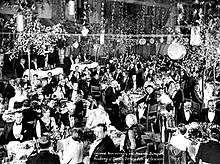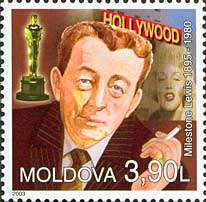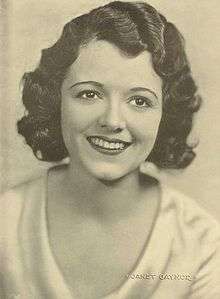1st Academy Awards
| 1st Academy Awards | |
|---|---|
 The first Academy Awards was at the Hollywood Roosevelt Hotel. | |
| Date | May 16, 1929 |
| Site |
Hollywood Roosevelt Hotel Hollywood, Los Angeles, California, U.S. |
| Hosted by | Douglas Fairbanks |
| Highlights | |
| Best Picture | Wings[1] |
| Most awards | 7th Heaven and Sunrise (3) |
| Most nominations | 7th Heaven (5) |
The 1st Academy Awards ceremony, presented by the Academy of Motion Picture Arts and Sciences (AMPAS), honored the best films of 1927 and 1928 and took place on May 16, 1929, at a private dinner held at the Hollywood Roosevelt Hotel in Los Angeles, California. AMPAS president Douglas Fairbanks hosted the show. Tickets cost $5 (which would be $69 in 2016 considering inflation), 270 people attended the event and the presentation ceremony lasted fifteen minutes. Awards were created by Louis B. Mayer, founder of Louis B. Mayer Pictures Corporation (at present merged into Metro-Goldwyn-Mayer). It is the only Academy Awards ceremony not to be broadcast either on radio or television.
During the ceremony, the AMPAS presented Academy Awards (now commonly referred to as Oscars) in twelve categories. Winners were announced three months before the live event. Some nominations were announced without reference to a specific film, such as for Ralph Hammeras and Nugent Slaughter, who received nominations in the now defunct category of Engineering Effects.[2] Unlike later ceremonies, an actor or director could be awarded for multiple works within a calendar year. Emil Jannings, for example, was given the Best Actor award for his work in both The Way of All Flesh and The Last Command. Moreover, Charlie Chaplin and Warner Brothers each received an Honorary Award.[3][4]
Major winners at the ceremony included 7th Heaven and Sunrise, which each received three awards, and Wings, receiving two awards. Among its honors, Sunrise won the award for Unique and Artistic Picture and Wings won the award for Outstanding Picture (now known as Best Picture). These two categories at the time were seen as equally the top award of the night intended to honor different and equally important aspects of superior film making. The next year, the Academy dropped the Unique and Artistic Picture award, and decided retroactively that the award won by Wings was the highest honor that could be awarded.[2]
Background
In 1927, the Academy of Motion Picture Arts and Sciences (AMPAS) was established by Louis B. Mayer, originator of Louis B. Mayer Pictures Corporation, which then would be joined into Metro-Goldwyn-Mayer (MGM). Mayer's purpose in creating the award was to unite the five branches of the film industry, including actors, directors, producers, technicians, and writers.[5] Mayer commented on the creation of the awards "I found that the best way to handle [filmmakers] was to hang medals all over them ... If I got them cups and awards they'd kill them to produce what I wanted. That's why the Academy Award was created".[6] Mayer asked Cedric Gibbons, art director of MGM, to design an Academy Award trophy.[5][7] Nominees were notified through a telegram in February 1928.[5] In August 1928, Mayer contacted the Academy Central Board of Judges to decide winners.[5] However, according to the American director King Vidor, the voting for the Academy Award for Best Picture was in the hands of the AMPAS founders Douglas Fairbanks, Sid Grauman, Mayer, Mary Pickford and Joseph Schenck.[8]
Ceremony
The ceremony was held on May 16, 1929,[1][3][4][9] at the Hollywood Roosevelt Hotel, located in Los Angeles, California.[3] It consisted of a private dinner with thirty-six banquet tables,[10] where 270 people attended and tickets cost five dollars (equivalent to $69.02 in 2015).[3] Actors and actresses arrived at the hotel in luxury vehicles, where many fans attended to encourage celebrities.[10] The ceremony was not broadcast on radio or television,[3] and was hosted by AMPAS director Fairbanks,[1][3][4][11] during a fifteen-minute-long event.[9]
Winners and nominees
Winners were announced three months before the ceremony.[3][4][9] The recipients included: Emil Jannings, the inaugural first award recipient [3] for Best Actor (The Way of All Flesh and The Last Command);[4][9] Janet Gaynor for Best Actress (Seventh Heaven, Street Angel and Sunrise: A Song of Two Humans); Frank Borzage for Best Director, Drama (Seventh Heaven); Lewis Milestone for Best Director, Comedy (Two Arabian Knights); and Wings for Best Picture (the most expensive film of its time).[1][2] Two presentations were made of a Special Award: Charlie Chaplin, a multiple nominee for one movie (Best Actor, Best Writer and Best Director, Comedy; all for The Circus) having been removed from the list so as to recognize his total contribution to the industry;[4] and Warner Brothers, an award for pioneering talking pictures (The Jazz Singer). Three categories were eliminated for subsequent presentations: Best Engineering Effects, Best Title Writing, and Best Unique and Artistic Quality of Production.[2] The larger film producers received the preponderance of awards: Fox Films Corporation, MGM, Paramount Pictures, Radio-Keith-Orpheum and Warner Brothers Production.[5]
Awards
Winners are listed first and indicated with double dagger ![]()
|
Unique and Artistic Picture
|
|
|
|
Best Engineering Effects
|
Best Writing, Title Writing
|
Honorary Awards
- Charlie Chaplin
- "For versatility and genius in acting, writing, directing and producing The Circus".[3]
- Warner Brothers Production
- "For producing The Jazz Singer, the pioneer outstanding talking picture, which has revolutionized the industry".[3]
Multiple nominations and awards
|
The following six films received multiple nominations:
|
The following three films received multiple awards:
|
Gallery
| Academy Award winners – Gallery | ||||||||||||||
|---|---|---|---|---|---|---|---|---|---|---|---|---|---|---|
|
See also
References
- 1 2 3 4 5 "This day in History". History. A&E Television Networks. Retrieved October 5, 2010.
- 1 2 3 4 "The Official Academy Awards Database". Academy of Motion Picture Arts and Sciences. Retrieved February 18, 2012. Reader must select "1927/28" in the "Award Year(s):" drop-down menu and press "Search".
- 1 2 3 4 5 6 7 8 9 10 "History of the Academy Awards". Academy of Motion Picture Arts and Sciences. Archived from the original on April 8, 2010. Retrieved May 6, 2010.
- 1 2 3 4 5 6 Dirks, Tim. "1927–28 Academy Awards Winners and History". Rainbow Media. Retrieved May 6, 2010.
- 1 2 3 4 5 Cosgrave 2007, p. 1
- ↑ Eyman 2005, p. 117
- ↑ Eyman 2005, p. 209
- ↑ Eyman 2005, p. 138
- 1 2 3 4 Pawlak, Debra Ann. "The Story of the First Academy Awards". The MediaDrome{{inconsistent citations}}
- 1 2 Cosgrave 2007, p. 4
- ↑ "Names make news". Time Magazine. Time Inc. May 27, 1929. Archived from the original on October 27, 2010. Retrieved October 5, 2010.
Bibliography
- Cosgrave, Bronwyn (2007). Made for Each Other: Fashion and the Academy Awards (I ed.). New York, United States: Bloomsbury Publishing USA. ISBN 978-0-7475-7630-3. OCLC 74523691.
- Eyman, Scott (2005). Lion of Hollywood: the life and legend of Louis B. Mayer (I ed.). New York, United States: Simon & Schuster. ISBN 0-7432-0481-6. OCLC 57506846.





